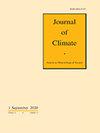巴伦支-喀拉海冬季深暖与浅暖在季节内时间尺度上的对比
IF 4.8
2区 地球科学
Q1 METEOROLOGY & ATMOSPHERIC SCIENCES
引用次数: 0
摘要
北极变暖的垂直结构具有重要意义,越来越受到关注。本研究根据巴伦支海-卡拉海(BKS)的平均温度分布,定义了两种类型的北极变暖事件(深部和浅部),然后通过热力学诊断比较了它们的特征并检查了它们的生成差异。北极深层变暖事件——其特征是从地表延伸到对流层中上部的显著底部重变暖——从格陵兰岛东部发出,然后主要通过纬向温度平流向BKS下游移动。深度变暖事件的高峰日比格陵兰东南部的降水和由此产生的非绝热加热晚了大约四天,这表明中高层BKS变暖可能是由北大西洋高纬度上游对流增强引发的。相比之下,浅层变暖事件——表现为对流层下部的变暖——之前是欧亚大陆内陆暖空气的经向平流。在浅层变暖事件期间,欧亚大陆上空的这些异常南风与加深的冰岛低压向东延伸有关。在深度变暖事件期间,冰岛低压的原位增强有利于与格陵兰东南部地形相互作用的丰富水分输送,导致那里的强降水和潜热释放。深度和浅层变暖事件都伴随着欧亚大陆的降温,但深度变暖事件的相应降温要强烈得多。此外,季节内北极深层变暖事件可以解释暖北极-冷欧亚大陆异常冬季平均变化的近一半。关于北极变暖是否影响中纬度的不同结论阻碍了对暖北极-冷欧亚大陆(WACE)现象的清晰理解。最近的研究结果表明,在年际或更长的时间尺度上,欧亚大陆的降温往往发生在北极深层而非浅层变暖的情况下,这引起了人们对北极变暖垂直结构的日益关注。在此基础上,我们将季节内北极变暖事件分为深部和浅部两组,并从各个方面进行对比。出现在格陵兰岛东部附近,与上游对流活动有关,季节内北极深层变暖事件伴随着欧亚大陆的显著降温,这在很大程度上决定了季节平均WACE条件。然而,由于欧亚大陆的经向温度平流,浅层变暖事件与欧亚大陆的冷却相关性较小。本文章由计算机程序翻译,如有差异,请以英文原文为准。
Contrasting Deep and Shallow Winter Warming over the Barents–Kara Seas on the Intraseasonal Time Scale
The vertical structure of Arctic warming is of great importance and attracts increasing attention. This study defines two types of Arctic warming events (deep versus shallow) according to their temperature profiles averaged over the Barents–Kara Seas (BKS), and thereupon compares their characteristics and examines their difference in generation through thermodynamic diagnoses. A deep Arctic warming event—characterized by significant bottom-heavy warming extending from the surface into the middle-to-upper troposphere—emanates from the east of Greenland and then moves downstream toward the BKS primarily through zonal temperature advection. The peak day of deep warming event lags that of the precipitation and resultant diabatic heating over southeast Greenland by about four days, suggesting that the middle-to-high tropospheric BKS warming is likely triggered by the enhanced upstream convection at the North Atlantic high latitudes. In contrast, a shallow warming event—manifested by warming confined within the lower troposphere—is preceded by the meridional advection of warm air from inland Eurasia. These anomalous southerlies over Eurasian lands during shallow warming events are related to the eastward extension of the deepened Icelandic low. During deep warming events, the in situ reinforcement of the Icelandic low favors abundant moisture transport interplaying with the southeast Greenland terrain, leading to intense precipitation and latent heat release there. Both deep and shallow warming events are accompanied by Eurasian cooling, but the corresponding cooling of the deep warming event is profoundly stronger. Further, intraseasonal deep Arctic warming events could explain nearly half of the winter-mean change in the warm Arctic–cold Eurasia anomaly.
Divergent conclusions on whether Arctic warming is influencing the midlatitudes impede a clear understanding of the warm Arctic–cold Eurasia (WACE) phenomenon. Recent findings that on the interannual or longer time scales, Eurasian cooling tends to occur in the presence of deep rather than shallow Arctic warming have attracted increasing concern regarding the vertical structure of Arctic warming. On this basis, here we classify intraseasonal Arctic warming events into deep and shallow groups and contrast them from various aspects. Emerging near eastern Greenland and associated with upstream convection activities, intraseasonal deep Arctic warming events are accompanied by significant Eurasian cooling, largely determining the seasonal-mean WACE condition. However, caused by meridional temperature advection from Eurasian lands, shallow warming events less correlate with Eurasian cooling.
求助全文
通过发布文献求助,成功后即可免费获取论文全文。
去求助
来源期刊

Journal of Climate
地学-气象与大气科学
CiteScore
9.30
自引率
14.30%
发文量
490
审稿时长
7.5 months
期刊介绍:
The Journal of Climate (JCLI) (ISSN: 0894-8755; eISSN: 1520-0442) publishes research that advances basic understanding of the dynamics and physics of the climate system on large spatial scales, including variability of the atmosphere, oceans, land surface, and cryosphere; past, present, and projected future changes in the climate system; and climate simulation and prediction.
 求助内容:
求助内容: 应助结果提醒方式:
应助结果提醒方式:


